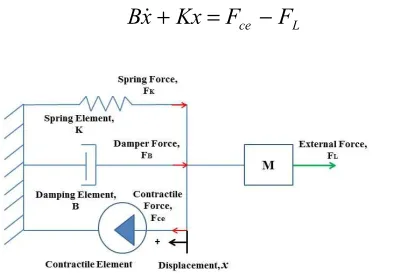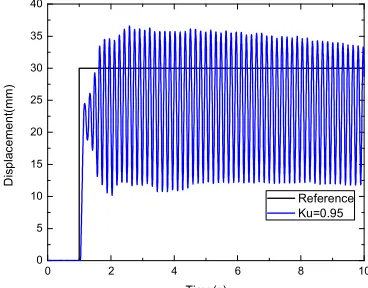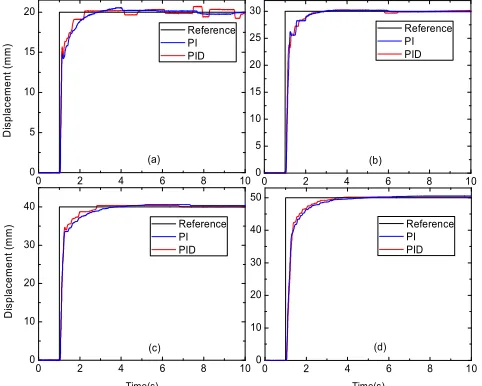Motion Control of a 1-DOF Pneumatic Muscle
Actuator Positioning System
Vasanthan SAKTHIVELU, Shin-Horng CHONG
Center for Robotic & Industrial Automation (CeRIA), Faculty of Electrical Engineering, Universiti Teknikal Malaysia Melaka Hang Tuah Jaya, 76100 Durian Tunggal, Malacca, MALAYSIA
Abstract— A positioning system driven by a pneumatic muscle actuator was built in order to study the applicability and adaptability of the system into real time applications such as exoskeleton robots and industrial machines. PMA system has many advantages including high power to weight and power to volume ratio, light weight, clean, autonomous and safe. However, the highly nonlinear characteristics of PMA system made it difficult to control. This has been the main challenge in proposing a robust controller for positioning and tracking performance. This study aims to clarify a practical and easy to design controller design procedure for positioning of a PMA system. In addition to positioning performance, the present study focuses on the realization of easy to design a controller without the need for exact model parameters and knowledge in control theory for systems with high nonlinearities. A PI and PID controller using Ziegler-Nicholas design law is proposed and its PTP performance is presented. Finally, the robustness of the proposed controller have been tested in a tracking environment by using triangular and sinusoidal waveform.
Keywords—Pneumatic Muscle Actuator; Festo Fluidic Muscle; PID Controller; Ziegler Nicholas Method
I. INTRODUCTION
A pneumatic muscle actuator (PMA) is a tube-like actuator that copies the conduct of human skeletal muscle, where the actuator length decreases when pressurized [1]. It has a high power-to-weight ratio and good flexibility due to its soft structure [2]. PMAs are significantly a light weight actuator, which are characterized as smooth, fast response, cost effective, clean and compact. This actuator is able to produce significant force when it is fully contracted. Its intermediate positions can be set by regulating pressure inside the actuator. Besides that, this actuator is also suitable in harsh environments due to no moving parts such as pistons or guiding rods [3]. At the same time, due to the friction acting inside the braided mesh caused by pressure and hysteresis, the PMA carries a highly nonlinear characteristic. Therefore, inaccuracy and difficult to control has become a significant problem in PMA system. In order to address the problem of PMA control by using a classic controller, a proper calibration method is required. A proper tuning method of classical PID controller will make it possible to be embedded in a nonlinear system.
Pneumatic Muscle Actuator, also known as the McKibben Pneumatic Artificial Muscle (PAM), Fluidic muscle [4] or Biomimetic Actuator [5], was first invented in the 1950s by the physician, Joseph L. McKibben for an orthotic appliance for polio patients [6]. In the 1980s, Bridgestone Rubber Company of Japan commercialized the actuator by redesigning and making it more powerful for robotic applications. The construction of PMA has made it possible for many kinds of humanoid applications and advanced robots. The PMA is used as the main robotic actuator in applications where compliance and high power to weight ratio are important, e.g. walking/running machines such as humanoid robots [7]. Fig. 1 shows the photograph of Festo Fluidic muscle.
Fig. 1. Commercially used PMA, Festo Fluidic muscle [8].
The typical manufacturing of a PMA can be found as a long synthetic structure of natural rubber tube, wrapped inside man-made netting, such as Kevlar, at predetermined angles [9]. Protective rubber coating surrounds the fibber wrapping and two fixed connection flanges at its ends. A pulling force is generated in axial direction, resulting in a shortening of the muscle as air pressure is increased. The PMA generates its maximum force at the beginning of the contraction and it decreases with an increase in the contraction.
Due to the high demand in the robotic applications which requires high positioning accuracy, the advantages of the pneumatic muscle actuator made it desirable in point-to-point positioning systems. In order to overcome the nonlinear problems and to achieve a robust PTP positioning performance, many challenges must be taken into account. The main idea in this study is to demonstrate a classical controller on a nonlinear PMA system. A classical PID
controller is typically easy to design and has high adaptability characteristics. Thus, to improve the positioning performance of the PMA system, a Proportional Integral Derivative controller has been designed and their PTP and tracking performance has been examined experimentally. The key point in achieving a good performance from a linear controller is by a proper design procedures and tuning method.
The main aim of this paper is to present a classical PI and PID controller performance in motion control of a 1-DOF pneumatic muscle actuator positioning system. The section of this paper starts with a brief explanation about the dynamic modeling of PMA and experimental setup developed. Then the section IV focuses on explaining the control objectives and its design procedures. The performance of the proposed controller has been tested with different types of input and its usefulness has been demonstrated in section V. Finally, this paper concludes the PTP and tracking results, and the usefulness of the proposed controller been presented.
II. MODELING OF PMA
The three element phenomenological modeling is the selected mathematical modeling in this research. The mathematical model explained in this section is to give a rough idea about the system characteristics and dynamics. The result and discussion about the optimized parameter is explained in detail in the previous publication [10]. The three element phenomenological modeling is explained. Assuming that x is the displacement/contraction of the PMA, the governing equation of motion for the three element phenomenological model is written as:
L ce
F
F
Kx
x
B
x
M
+
+
=
−
(1)where
M
is the mass at one end of the PMA,K
is the spring coefficient,B
is the nonlinear damping coefficient,F
ceis thecontractile force coefficient and
F
L is the external load acting on the system. The contractile force coefficient is the contraction force that has been generated by the muscle due to pressurization (increase in muscle diameter and decrease in muscle length). The contractile force coefficient is assumed to be equal to the external load applied to the PMA, which results in zero contraction of the PMA [11].Note that when
F
ce=
F
Lwhich results in zero initialcontraction and velocity [
x
(
0
)
=
x
(
0
)
=
0
], no motionoccurs in the system. When
F
ce>
F
L, the right hand side ofthe Eq. 1 is the driving force for the system.
The dynamic contraction and static load study experiments have been conducted in a horizontal experimental setup. The following assumption has been made to neglect the initial term,
M
in data collection. In the horizontal setup, one end of the muscle is fixed with the load cell and the other end isfixed with the table/mass. This is reasonable to assume that half of the muscle weight is supported. It only contributes less than 1% of the total contraction of the PMA. Since this is a low mass system, the element
M
is been neglected [12]. Once, neglecting the initial term in the model, the simplified equation is shown in Eq. 2. Fig. 2 presents the three element phenomenological model free body diagram.L
ce
F
F
Kx
x
B
+
=
−
(2)Fig. 2. Three-element phenomenological model of PMA.
III. EXPERIMENTAL SETUP
An experimental setup for motion control of the pneumatic muscle actuator system has been developed for this research.Fig. 3 presents the experimental setup of the system in this research and Fig. 4 visualizes the schematic view of the PMA system. The PMA used in this study was Festo Fluidic Muscle Actuator (MAS-20-250N-AA-MC-K) as the main driving element. The actuator has a nominal length of 250mm and 20mm of diameter. The experiment conducted was based on previously developed experimental setup [13], but with some modification in the sensing part as shown in Fig. 3. The PMA was investigated using an experimental setup that allows precise and accurate actuation, controlled by a Festo Proportional Pressure Regulator (PPR) model (MPPE-3 1/8-6-010B) manufactured by Festo. The system was tested by observing the PMA contraction for different step input of pressure. The length changes of the PMA were measured by a Linear Variable Differential Transducer (LVDT) model SR-Series VR 100.0SBLS with the resolution of <0.5µm manufactured by Solartron metrology.
The air supply to the system was supplied by a mini air compressor model Kinki (KAC-14 6L 1/4HP 100PSI). The low friction of the table was assumed to be neglected. Therefore, it was routinely lubricated to ensure minimal friction in the data collection process. Data was collected at a 500Hz sampling frequency. Pressure range of the experiments was 50-550kPa (0.5-5.5bar) which is 10-55mm.
Fig. 3. Schematic view of the experimental setup.
Fig. 4. Experimental setup photograph.
IV. PIDCONTROLLER SYSTEM DESIGN
One of the main objectives of the PMA system developed is to achieve an accurate point-to-point positioning motion. This section will cover the classical control design procedure and its performance evaluation. A classical Proportional Integral Derivative (PID) controller is designed for PTP positioning. The gain calibration has been done by using the Ziegler Nicholas tuning method1 as shown in TABLE I. The PI and PID controller are designed based the following procedures: First, the mechanism is driven with a proportional gain only. Then, the proportional gain is increased until a sustained oscillation occurred. The calibrated optimum proportional gain is defined as Kc (critical proportional gain)
(see Fig. 5). Next, the ultimate period Tc, which is the time
required to complete one full oscillation while the system is at steady state is noted. By using the Kc and the Tc parameters,
the values of Kp and Ki can be determined by referring to
TABLE I.
TABLE I. ZIEGLER NICHOLAS TUNING LAW CHART
PID Type Kp Ki Td
P 0.5Kc Inf 0
PI 0.45Kc Tc/1.2 0
PID 0.6Kc Tc/2 Tc/8
Fig. 5 shows the response of the system whereby the critical gain, Kc was determined. The calibrated Kc is 0.95 and
Tc is at 7.532 seconds. According to TABLE I, the calculated
proportional gain, Kp is 0.57, integral gain, Ki is 3.766, and Kd
is 0.9415. The obtained PID gain is from the mid contraction of 30mm. In order to fit lower contraction, mid contraction and higher contraction (10-50mm with 10mm increment) the gain value has been optimized from the calculated value to meet the desired steady state and transient performance. The new optimized Kp is 0.57, Ki is 1.555 and Kd is 0.01. This
value has been used as the PID gain for both PI and PID controller. Fig.6 shows the block diagram of the control system. The control system includes the PID controller and a linearizer unit. The linearizer holds the static relationship of the input voltage and the table position which is obtained via open loop experiments.
Fig. 5. Response of the system with critical gain, Kc.
Fig. 6. Block Diagram of the control system.
V. RESULT AND DISCUSSION
In this section, the positioning performance of the PMA system is presented. Fig. 7(a-d) shows the point-to-point positioning responses of the PMA system to a step input with
Kp
Ki/s
KDs +
-+ +
+
Mechanism
Xr X
Linearizer Unit PID
0 2 4 6 8 10
0 5 10 15 20 25 30 35 40
D
is
p
la
c
e
m
e
n
t(
m
m
)
Time(s)
PI and PID controller. The blue solid line represents the experimental result of the PI controller and the red solid line represents the experimental results of thePID controller. The positioning performance of the PMA system was examined for the contraction range from 10mm to 50mm, with a step increment of 10mm. However, only the positioning results of the lowest contraction, mid contraction and highest contraction are presented in this section.
Fig. 7. PI and PID controller response of the PMA system to step wise inputs.
The positioning results in Fig. 7(a) shows that the PMA system exhibits oscillation (limit cycle) due to the static friction effect at lower contraction, but the steady state error recorded were maintained between ±100µm. The classical PI and PID controllers performs significantly, with no overshoot recorded for all the displacement tested. Besides that, the small settling time, rise time and steady state error shows the overall performance of the classical controller . As per seen in Fig. 7(a) the recorded oscillations for the lower contraction main reason the proportional gain and integral gain have been tuned and optimized to a suitable value to maintain the overall steady state error below ±800µm for PID controller and below ±600µm for PI controller as per shown in TABLE II. TABLE II shows the step response information on the PMA system for PTP positioning. As shown in the TABLE II the PI controller recorded a settling time below 5s, whereby the PID recorded below 9.8s due to the stick slip effect. Although, the rise time recorded for the PID controller were better as compared to the PI controller, the overall PID controller performances were poor compared to the PI controller. The PID controller performance was poor for the lower contraction compared to
the higher as per the experimental result in Fig. 7(c-d). The result presented in this paper is significant to prove that, PID controller by using Ziegler Nicholas tuning method can perform in nonlinear system, but it is not very suitable for system which requires precision positioning. As discussed, the PI controller performs better compared to the PID controller. Due to this matter, the PI controller has been further validated in tracking control environment.
TABLE II. PMA SYSTEM STEP RESPONSE INFORMATION FOR PTP POSITIONING
Controller Displacement Rise Time,
Fig. 8. PI controller response of the PMA system to triangular waveform.
Fig. 9. PI controller response to sinusoidal waveform inputs at a frequency of 0.1Hz at 30mm displacement.
Fig. 10. PI controller response to sinusoidal waveform inputs at a frequency of 0.05Hz at 40mm displacement.
VI. CONCLUSION
A study on the high force pneumatic muscle actuator system with shows great promise in robotic and industrial applications, but it has an immanent difficulty in developing accurate positioning control due to its nonlinear characteristics. A Ziegler-Nichols tuned PI and PID controller was proposed and validated experimentally in positioning and tracking performance. The presented results showed some
significant in PTP positioning with minimal steady state error. By implementing a linear controller onto a nonlinear system, it’s able to produce reasonable steady state and transient response in the range of displacement tested. The PI controller showed adequate response compared to the PID for the lower and higher contraction study conducted. The point-to-point and tracking result were helpful to prove the applied Ziegler-Nicholas tuning method is sufficient to prove the performance of the classic controller. However, due to the linear system in the future works.
ACKNOWLEDGEMENT
I would like to thank Universiti Teknikal Malaysia Melaka and MOSTI for the RAGS/2012/FKE/TK02/3 B00010 research grant.
REFERENCES
[1] Hall, Kara Lynn, Dynamic Control for A Pneumatic Muscle Actuator to Achieve Isokinetic Muscle Strengthening. P.h.d. thesis, Wright State University, 2011.
[2] D.W. Repperger, C.A. Phillips, et al,“Power/Energy Metrics for controller Evaluation of Actuators Similar to Biological Systems,”
Mechatronics, Vol. 15, No.4, pp. 459-469, May 2005.
[3] Lightner, S .The fluidic muscle: a ‘new’ development, The International Journal of Modern Engineering, Vol. 2, pp.2, 2001.
[4] J. Yarlott, “Fluid actuator,” US Patent No.3 645 173, 1972.
[5] D.Caldwell and N.Tsagarakis, “Biomimetic actuator in prosthetic and rehabilitation applications,” Technology and Health Care, pp.107-120, 2002.
[6] H. Schulte, The characteristics of the McKibben Artificial Muscle, The Application of external Power in Prosthetics and Orthotics, Lake Arrowhead, pp. 94-115, 1961.
[7] D. Caldwell, N. Tsagarakis, D. Badihi, and G. Medrano-Cerda, “Pneumatic Muscle Actuator technology: a lightweight power system for a humanoid robot,” in proceedings of the IEEE International Conference on Robotics and Automation, Leuven, pp. 3053-3058, 1988. [8] Festo Corporation. Fluidic Muscle DMSP/MAS. [Online] October 2012.
https://xdki.festo.com/xdki/data/doc_engb/PDF/EN/MAS_En.PDF. [9] E. Kelasidi, G.Andirikopulos, G.Nikolakopoulus* and S.Manesis, “A
Survey on Pneumatic Muscle Actuator Modeling,” IEEE, vol.11, pp.1263-1269, 2011.
[10] S.Vasanthan, Shin-Horng Chong and Mariam Md Ghazaly, “Modeling the Pneumatic Muscle Actuator using Phenomenological model,” in Proceedings of the 2nd Power and Energy Conversion Symposium (PECS), pp. 339-344, 2014.
[11] D.B. Reynolds, D.W. Repperger, C.A.Philips, and G.Bandry, “Modeling the Dynamic Characteristics of Pneumatic Muscle,” Annals of Biomedical Engineering, Vol. 31, pp. 310-317, 2003.
[12] Maria J. Gerschutz, Chandler A. Philips, David B. Reynold & Daniel W. Repperger, “A computational simulated control system for a high-force pneumatic muscle actuator: system definition and application as an augmented orthosis,” Computer Methods in Biomechanics and Biomedicalengineering, 12:2, 173-183, 2009.
![Fig. 1. Commercially used PMA, Festo Fluidic muscle [8].](https://thumb-ap.123doks.com/thumbv2/123dok/503018.56602/1.595.307.503.392.482/fig-commercially-used-pma-festo-fluidic-muscle.webp)



